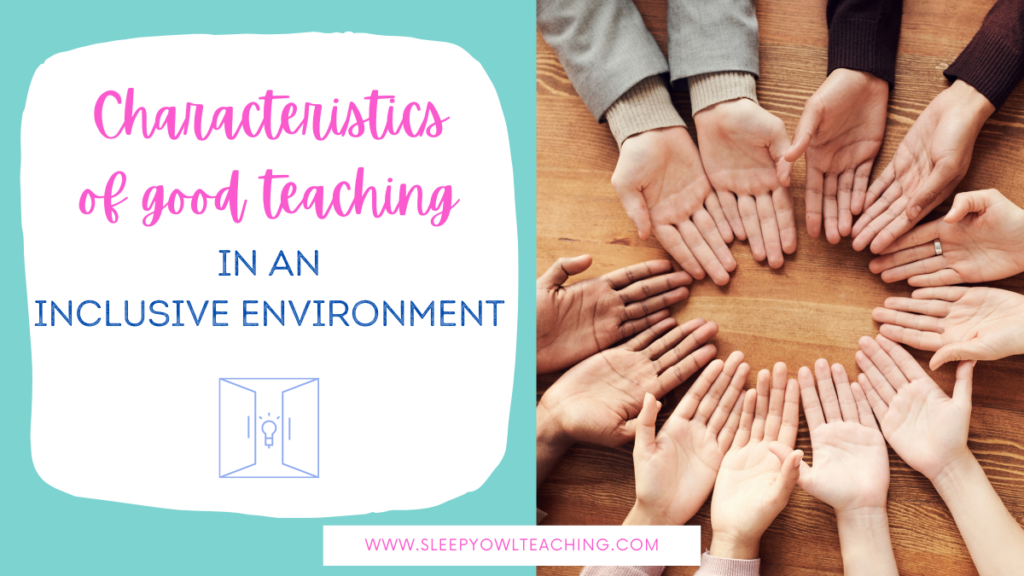You may be asking yourself “What are the characteristics of good teaching when it comes to inclusion?” Well, let’s continue on this inclusion journey we started a while back. Today I want to talk about the characteristics of an effective teacher that foster an inclusive environment. During my 14 years of experience in special education, I’ve come to notice what helps make a great inclusion environment and what is less successful.

In this article, I’ve compiled a list of successful strategies of effective general education teachers that I’ve noticed in my years working in special education. However, each and every one of these is a great strategy for EVERY student in the classroom, whether they have an IEP or not.
Ownership
The number one most important quality, in my opinion, when thinking about what are the characteristics of good teaching in an inclusive environment is general education teachers taking ownership of all students. Often when teachers have students coming in and out of the classroom for certain subjects, or even just for social situations, it is hard to think of those students as “theirs”. The teachers who have the most success in fostering relationships with students, teachers, and parents are the teachers who consider every student who walks into their classroom as part of their class.
For some, this is easier than others. But having the mentality of “oh, I don’t need to worry about that kid, he has another teacher to do everything” or “I have all these other students I need to worry about, I will let someone else worry about this student” does not build an inclusive community. In fact, it is quite the opposite as it shows that student and all the other students in the classroom that he or she doesn’t really belong. For example, one year I had a general education teacher that I worked with volunteer to take an AAC class so she could better communicate with the nonverbal student we shared. Imagine what it felt like to this student to have another adult who could communicate with him in his way in his classroom community.

Organization
The second thing that helps students have success is maintaining an organized classroom environment. Some people are better at organizing than others. I’ll be the first to admit I am not always organized and I can generate clutter, but I try to stay on top of it. Clearly marked areas and supplies can be very helpful to students and help streamline learning and foster independence. Some teachers think that the more they have on the walls, the better the teacher they are. However, this can be very distracting to students. Often, less is more. Focus on what is most important and get rid of the rest. Another thing to consider is the seating assignments. Seating students who are more distractible away from windows or open doors is a good strategy.
Giving Directions
The next characteristic of good teaching in an inclusive environment is to break down directions into smaller, more manageable tasks. Checklists are awesome for this. You could use a checklist for a morning arrival routine or independent center work that might feel overwhelming. Visuals are a great support for verbal directions. Also, when giving directions, focus on that one direction until each task is completed before moving on. This will ensure all tasks get completed and nothing gets forgotten.
Tone of Voice
Another quality that is important for teachers to pay attention to when thinking about what are the characteristics of good teaching is their tone of voice when communicating. We all get tired and frustrated as the day goes on, or wake up on the wrong side of the bed, but we need to keep our tone consistent throughout the day. A calm, gentle voice goes a long way towards creating a supportive community environment. I’ve heard teachers who use a loud, abrasive voice. This can cause anxiety in students and even escalate students who are already feeling emotional. When an emotional response kicks in, students often stop listening to teacher directions and only hear their tone of voice. Keeping our voice neutral throughout the day ensures a calm attitude for all.

Opportunities for Success
The last strategy that I’ve seen great inclusion teachers use is to give students with special needs (and all students) opportunities for success. Students with special needs often need more time or assistance to succeed in the general education classroom both academically and behaviorally. If we build in opportunities for success, even if it means prepping them ahead of time for the correct answer or an activity, they can feel successful and their peers can see that they are valuable contributors to the class. The biggest thing to remember is that we need to teach them the expectations and follow through when they meet them. Teaching and modeling behavioral expectations explicitly is a must instead of just expecting that they will pick them up along the way.
For more information on interacting successfully with students, check out these articles.
Building positive relationships with students struggling with mental health.
Is Your Classroom Organized for Learning?
Promoting Inclusive Education: The Roles of Teachers’ Competence and Attitudes
As you can see, showing ownership, having an organized classroom, breaking down instructions, using a neutral tone of voice, and giving students opportunities for success are all strategies that answer the question “What are the characteristics of good teaching in the inclusive environment?” These are strategies that good inclusion teachers use to foster community and student success.

What characteristics of an effective teacher do you look for in great inclusion classrooms? What can you implement more in your own classroom? Let me know in the comments or find me on Instagram @sleepyowlteaching!

